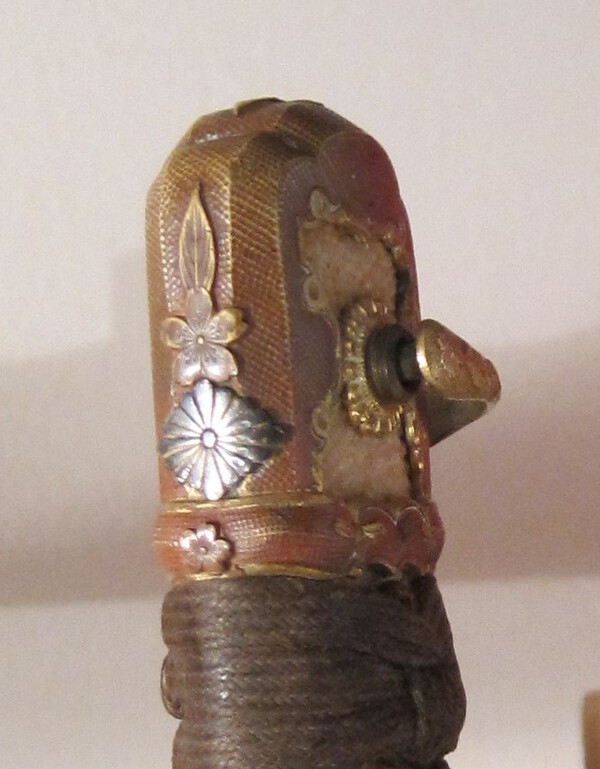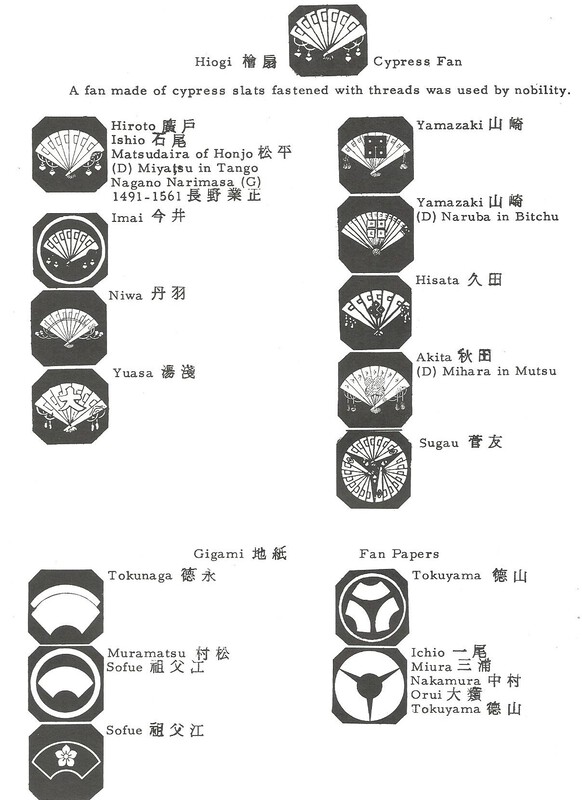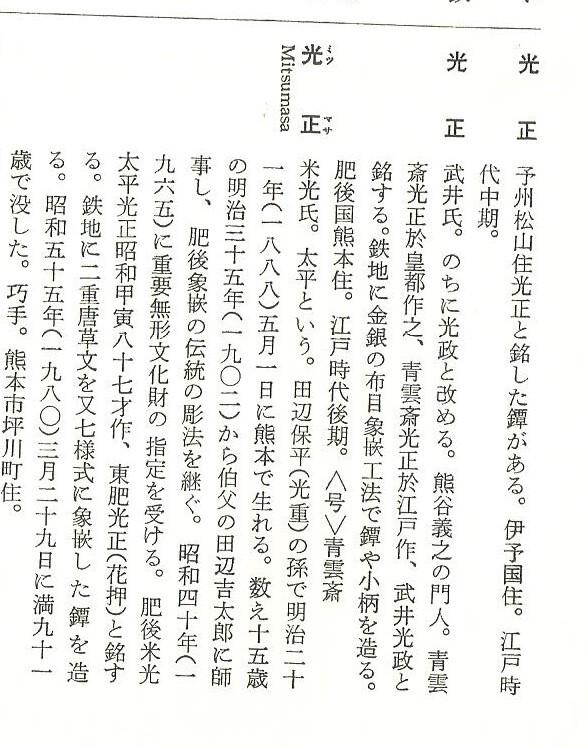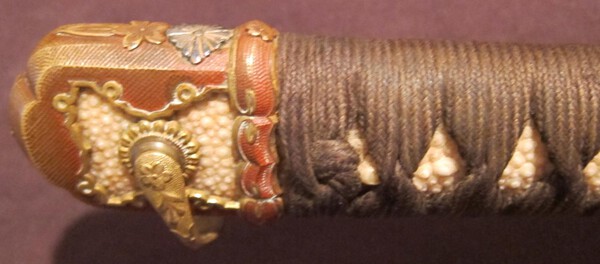-
Posts
2,988 -
Joined
-
Last visited
-
Days Won
14
Content Type
Profiles
Forums
Events
Store
Downloads
Gallery
Everything posted by george trotter
-

Show off your Nihonto book collection
george trotter replied to bigjohnshea's topic in General Nihonto Related Discussion
My office is too 'discombobulated' to take a picture, books all over the place, but nice to see the members' books. Some very good libraries there...but one thing I noticed (maybe I missed it?) is I don't see any copy of 'NIHONTO MEIKAN' by Homma & Ishii. A very good research tool for members - I prefer the pre-1996 edition. Regards, -
Hi Dave, Yes I guess in the end it must all come down to what we have actually seen ourselves. In my case, never having seen faults, I still have high regard for RJT. Keep up the good work,
-
Your comment prompts me to say that Morita sans "regulations for RJT' doc I translated has a line which states that any left-over bits of tamahagane had to be returned to the govt. I think this would also mean that 'failed' swords would also be 'recycled' by the govt. into new tamahagane for supply to RJT smiths. I think I remember seeing a pic of a box of tamahagane for the RJT scheme that had a 'level of quality' note on the box. This must mean (if my old memory is correct) that various grades of tamahagane were supplied to smiths. This stands to reason as every smelting cycle would likely use slightly different raw material sowould produce several levels of finished metal (or each smelting cycle produced one uniform level of metal, but each cycle's output varied from the next?)...so over time there were various grades of tamahagane used...some 'good, some better and some best', so it is probably correct what Dave said...the quality of the tamahagane varied so the quality of the sword varied....but whether this is connected to "thin skin" (which is a construction matter) I don't know. Thin skin would seem to be a 'choice' matter for the smith? From this I suppose it would be reasonable to say that the quality of RJT work varied as the Yasukunito varied (I wonder if they were supplied with the same tamahagane? Maybe there was only the one smelter?). Anyway, I think the standard of gendaito varies (as swords always have) but whether 1932-1945 swords are generally, or more often, inferior I have to say that I think Yasukunito and RJT are in general of superior / uniform quality, as is their forging.. Just me...
-
Hi Dave, Yes I see what you mean (if I have got it right)...the "average gendaito" is sometimes found with "thin skin" as gendaitosho don't always work to high standards. On this subject there will be varying views I am sure, all based on personal findings. I haven't got that book you mentioned but in order to assess some aspects of gendaitosho work I looked up the book 'The Yasukuni Swords' p.73-74. I did this to check both 'differing standards of gendaito quality' and to see if there was any mention of swords failing on the battlefield for weaknesses and structural problems. This book gives the Yasukuni inspection process and states that they had an inspection process that identified the Yasukunito as being rated as 3 grades, that is: 'good, better, best'. Swords could also fail this inspection. Prices were set on "good, better, best" and the variations are given on these pages. It doesn't say what happened to the rejected swords, neither does it mention any failures in those that passed inspection. Although not addressing faults or failures, this is a valuable record when you get discussions like this one. So, if Yasukuni blades had 3 gradings and prices (and failures), then it seems reasonable that RJT system may also have done this (failure does not get a star) so your discussion with Alan about seeing low quality in some gendaito seems reasonable. But there is more to it than this. Whether gendaitosho intentionally made differing grades of sword I don't know...but it occurs to me that in the sense that Yasukuni and RJT had rigid inspection standards it could be said that they are less likely to have intentional low quality than the "average gendaito" and as for flaws I suppose Yasukunito and RJT at least were assessed on whether they affect the serviceability of the blade in use? I mean, they wouldn't let a blade through that was structurally liable to fail in use would they? Thinking out loud about the original question of gendaito having 'thin skin', while Alan said "the average gendaito" did he mean to include Yasukunito and RJT? I ask as I think it less likely to be the case with Yasukunito and RJT due to the government control of tamahagane production and the two sword inspection systems put in place for Yasukunito and RJT. Since production quality was the result of dedicated smiths, government control and rigid inspection standards, then it would be fair to say that, unlike the Yasukunito and RJT (can't say about the "average gendaito") all swords made from say 1250 to say 1932 would be more likely to have low quality metals and structural flaws than Yasukuni and RJT blades wouldn't they?. I say this as it would be fair to say that no swordsmiths before Yasukuni in 1933 and RJT in about 1942 had to pass rigorous official metal controls and blade inspections by trained swordsmiths and metallurgists and technical experts. While flaws and several levels of quality may exist in Yasukunito and RJT, I think logic says they are likely to be superior to "the average gendaito", if not the average nihonto also. Having said that, I think we need more information/facts on why/how is it that the "average gendaito" (including Yasukuni + RJT) has gotten a reputation for having "thin skin"? Hope I'm not rambling or missing the point, Regards,
-
Hmmm, what to say. Firstly I agree with Dave that RJT are weapons...in fact the last nihonto made for war on the battlefield (that's why I collect them). Now about the quality...As I have never used a RJT blade for its intended purpose and have never had one polished, I am a bit 'under qualified' to make any profound statement here regarding this above view on quality. I can say however that I have never seen a star stamped RJT blade with flaws (presumably because they had to pass inspection). I have seen private order gendaito by prominent makers (eg. Suetsugu Shigemitsu - Fukuoka) with the worst open hada I have ever seen, yet still signed, dated and mounted for military use. Although the sample is small, this suggests that a star stamp would not appear on such a flawed sword. As to the 'hidden' quality, which only appears after a second polish, well I have not had such a sword in hand. What I have collected, based on my assessment: I have 4 RJT blades, all excellent quality (no flaws). I have 3 gendai gunto which would be classed as private order, also of excellent quality (2 not dated and 1 a private order by a RJT smith (no star). I have one 'mystery maker' which looks good but still has some unanswered questions about it and its quality. Some of these swords need a polish but I like them too much to submit them to modern Hadori polishers...I'd rather look at the WWII polish even with scratches etc. Because of this fact, I will never see my swords in a repolished state, so can only defend their quality based on my 50 years of sword knowledge (I am not saying the above view is wrong, I am just saying I have not seen it myself). You can look at my swords in the 'Japanese Swords in the Trotter Collection" document that Brian attached at the bottom of the index page. I wrote it just as a record of a small group of swords...some might enjoy a read, some may have the same swords and give us their opinion on their quality.. So, in closing, I can only say that "from what I've seen", the classifying of RJT into "good, better, best" is not something I have actually seen myself. The closest I suppose I could come is that not all RJT blades appeal to my taste. I have let a few go (even Yasukuni) because they didn't 'inspire' me...but I never saw a flawed or inferior piece of work amongst them...just didn't meet my taste. I will be interested to see what sort of feedback comes from this discussion. I have spoken as a collector who focuses on collecting "the last true fighting swords made for the purpose of war on the battlefield" Everything after 1945 is art...not for me (just my opinion). Knowing the dedication of the Japanese when they put their mind to it, it is hard to think their swordsmiths would make dodgy swords...maybe cheaper types based on clearly stated metal variations...but, will be interested to hear opinions. Regards to all,
-
Brian, I looked through the posts and don't think anyone answered your question...so here goes. Yes,when the Occupation forces decided to destroy all the confiscated swords held at the Akabane arsenal in Tokyo (not sure what year...1949?) there were about 5000 swords selected by the NBTHK for preservation and these were taken to the NBTHK (at Ueno?) and stored away and forgotten. About 20? years ago they started re-polishing these swords and as they got through them all it was proposed to return them (on loan?) to the original prefecture or city from whence they came. When I was in Hiroshima around 2010 I saw a display called "Akabane Swords" there. These were part of a sort of National Akabane Return Display. Whether they went back to NBTHK after a time I don't know...maybe they were actually returned to their original homes throughout Japan. Hope this helps.
-
Hi Thomas, Yes that is the series...I notice I said Shoshin rather than Shoshi (short/small history)...just more proof I am getting more ga-ga as I get older. The series of articles ran in TOKEN BIJUTSU ssues #146 Mar. 1969 #147 Apr 1969 #148 May 1969 #149 Jun 1969 #151 Aug 1969 #152 Sep 1969 #153 Oct 1969 Sequel/Addenda #166 Nov 1970 #167 Dec 1970 #498 Jul 1988 #503 Dec 1998 You are welcome Stephen, sorry I couldn't find any more info. Regards,
-
Hi Steven, I know what it' is like to have an "unknown" smith. I your case there is little known beyond.his name and location., but I did find this... Looking at the 'Nihon Gendaito Shoshin' Chap. IV p.10 and Addenda p.7 he was KOBAYASHI (Shigenori) NARIYUKI of Tokushima. He studied under Morita Masamichi of Kyoto. This Masamichi was a student along with Sumitani Masamine, both students of Sakurai Masayuki of the Sakurai school. Not much, but it might give you some leads... Regards,
-
Well, dang, I think you nailed it Jean. First time I have seen a tsuba mis-used in this way. BTW, sorry to have "butted in" to the original topic. Regards,
-
That is the first time I have seen a 'sleeved' nakago ana for use on a slimmer nakago? Usually just see two copper 'cushions' inserted. Also,,,What are the two alloy filled holes?... why holes? Regards,
-

Show us Your Commemoration/Presentation Swords
george trotter replied to Bruce Pennington's topic in Military Swords of Japan
About swords being made elsewhere and then presented to the shrine for blessing etc...of course this is common. but always remember there is also 'not always'. As an example, Ono says an RJT smith named Kanazaki Toshimitsu (Tottori) made swords at the Fushimi Inari Shrine in Kyoto in 1944/45 (Ono 'Gendai Toko Kinko Shokukata Soran' 1977, p.106) and this is expanded by Kishida who said this of Kanazakii: "By order of the military authorities, he made 30 swords at the Fushimi Inari Shrine of Kyoto and donated the swords to the shrine in January 1945. The chief priest of the shrine Suzuki Matsutaro gave him the personal title of "Inari Kokaji" on that occasion" (Kishida 'Yasukuni Swords' 2004 pp.134-5). This smith used several names including Suketoshi. So, there were occasions where swords were made at the shrine and dedicated there. I don't know how common this was or how many shrines actually had forges. Hope this helps. -
The kanji are correct...not sure of the pronoumciation of the first two, but they can be read as a name which is YASUMASA. There was a smith of this name KUNIMITSU working in Chikuzen in Bunwa era (1352) who was of the line? of Yasumasa?goro Sadamune. The yasumasa is the same (Nihonto Meikan p.297). Obviously this mei is fairly modern, maybe as late as 1900s, so it is not this koto smith, but maybe a later smith claiming some connection with the koto Kunimitsu who was connected with Yasumasa?goro Sadamune? Hope I am not off track here. The tsuba looks interesting. Regards,
-
Yes, me too. I have a Nakada Kanehide of Seki RJT blade in the metal saya double-button mounts with the light cream paint as shown in the showato pic. Kanehide is a very good smith (post-war mukansa). So the message is...though rare to find a gendaito in a brown metal saya Rinji Seishiki mount, it DOES occur. Always check them out at swap-meets etc, you just never know. The signature seems to be SUMI to me. There was a Kanesumi working in Seki from 27 Dec 1940, name SATO Yukihachi or Kohachi or Yukiya...or...other possibilities. Regards,
-

Identification Assistance Respectfully Requested
george trotter replied to echelonff's topic in Nihonto
hi Nate, I notice you have had no responses yet...well firstly, good on you for trying before asking for help. Your translation of the date is correct except the 18th year of Showa is actually 1943, not 1944...they did not start their cycles at '0' but at '1'. Second, the two kanji in the signature are quite stylised writing of KUNIHIRO. His family name is KATAOKA (not sure of personal name pronunciation : Chikashi?). He began as a sword maker at Seki on 13 Nov. 1941. About it being in a NCO mount...that is strange. From our experience it is more likely to be in the late war type of 'Rinji' (emergency) mounts. Maybe a pic of the fittings too so we can check them out? Regards, Edit: Oh I see Brian has corrected the date year. -
I should put in a better pic of that kikumon shown on Bruce/John's post just above. Families given in Hawley p.3 are non-royal families connected to the Imperial families. This "diamond" shape kiku is quite rare - Kimura, Nakamura, Toda families. Don't know how many used it in WWII. Regards,
-
According to Hawley's book MON 1976 p.60 it seems to be a variation of the Hiogi (fan) mon. Only one family is given for it, the SUGAU...as yours is "smooth" rather than "slatted" it must be either an allied family or maybe just some family who invented it for themselves after c.1850s. You'll need to do more searching. Regards,
-

Gunto pedigree ID requested
george trotter replied to Sea King 11's topic in Military Swords of Japan
Hi Chris, Well, having no stamps and no date says this sword was most likely made privately by Kanenori, that is, not in the SEKI official sword manufacture system. You will need to show it to a knowledgeable person for an opinion on whether it is gendaito (handmade sword) or Showato (semi-machine made). Just looking at the "style" of chiselling used in his name, it reminds me of the "usual" WWII mass-produced sword "official name-cutting guys" style, but I may be wrong. The fittings look good quality (total of 8 "washers" on either side of the guard...a good sign). Also, having the good fittings with the silver mon indicates that the buyer was a "well-to-do" officer. The mon is the KIRI (paulownia plant) with blossoms called 3/5. This is the mon of the Matsudaira clan who were governors in several provinces. It is also that of the Ashikaga clan, and after the 1800s was used by many families...pretty good mon to have. Kojima Kanenori's real name was Kojima Taro. Born in 1907. During the earlier years of the war he served as a swordsmith and teacher in the SEKI "system" so made various quality swords. From around 1943 he was a Rikugun Jumei Tosho (official Army Smith) so made very good quality handmade swords. You really need to get it looked at by someone who knows stuff. I'm not sure but I think he continued after the war and won many prizes and praise for his work. Worth checking out and if a good blade, get the hilt re-bound in the correct military style to return it to "original WWII sword of historic value"...just my opinion.. Regards, -

Gunto pedigree ID requested
george trotter replied to Sea King 11's topic in Military Swords of Japan
It is a WWII Type 98 gunto (military sword). It is signed KaneNori...look about an inch above this signature...if there is a stamp (either a "square" Seki stamp or a "flower" Sho stamp), it will mean it is semi-machine made. If there is no stamp then it might be hand-made. There was a Seki (town) smith named Kojima Kanenori who started making army swords in 1939. There should be an inscription on the opposite side which will be the date. I notice it has a small silver disc on the metal "cap" on the end of the handle...this is a silver "mon" (family crest), if you take a photo of it someone here might be able to tell you which family/families used this mon. The tassel is correct and legit...just a bit faded, which is common. Regards, -
Sorry Grev, I thought you used Japanese sources etc. I am not familiar with koshirae terms etc, not being a student of them, but I can tell you roughly, starting with right column Mitsumasa: Mitsumasa: Yoshu (the 'Yo' is only the left portion of the kanji) Matsuyama ju, Mitsumasa. Lived Iyo kuni (again the yo is only the left portion), Worked mid-Edo. This is today Ehime ken. Next Mitsumasa: Name Takei?. Kumadani? Yoshiyuki? school. Gives several examples of his mei, but none given have the kanji for 'Hi' or 'I'. His true 'masa' is the more complicated masa. Lived Higo kuni in Kumamoto. Worked late Edo. Next Mitsumasa: Name Yonemitsu. Called Taihei/Tachihira? He is of the Tanabe Yasuhiro line being born in Kumamoto (Higo) in Meiji 21 (1888). Worked with his grand? father from 1902. Died in 1980. All of these artists worked in the provinces that relate to your tsuba. Whether they used the kanji you asked about will need someone from your field to answer. Hope this helps (and does not just lead you astray). Regards,
-
This might help? A couple of references to "Hi" and "I" provinces for 3 Mitsumasas, including one coming up to Showa era. From "Toso Kinko Jiten" p.170 by Wakayama. Regards,
-
Just looking at the mon of Prince Asaka Yasuhiko and had a quick look on-line for mon under his name. Found this (1930s) on worthpoint. It is the same as the one on the sword. Interesting that his mon is 'hishi' (diamond) shape. I always thought these 'hishi' kiku-mon are the shape of 'non-royal' members/relatives of the Imperial family. Here also is one on a sword of mine (wonder who he was and if it is true about the 'hishi' non-royal mon?). Time for Bruce to look into it I think! Regards,
-
Just happened to re-read these posts and AAARRGGHH!!!! I noticed I said NIHON TOBU meant "North Area". Must have had a brain freeze as TOBU means "East Area"...that is those smiths working in the greater Tokyo area extending also to the east/north...not sure just how wide it was but it included Niigata on the coast north-east of Tokyo. I suppose if someone went through the 40+ membership list we could work out quite accurately how far it extended.. Sorry for the mistake. Regards, (edit to add) I don't want to labour the point, but a quick skim over some Japanese sources says that the Tobu system was conceived in late Sho 15 (1940) and by 1942 had 30 members in Tokyo, Kanagawa, Chiba, Saitama, Ibaraki, Gunma, Tochigi, Fukushima, Shizuoka and Nagano. By late 1942 smiths were engaging with the RJT scheme (I can't tell if they "changed" membership over) and by now numbered 46 smiths. From my own knowledge this now included smiths from Niigata ken. If the smiths were members of both systems I would assume that the collection/inspection system would stay the same...only the supply of raw materials and the payment system would be modified. This info is from "Dai Nihon Token Shoko Meikan" 1942 p.148. Hope this helps. (maybe one of our Japanese speakers could translate in more detail?) Regards,
-

Note for Markus Sesko
george trotter replied to george trotter's topic in General Nihonto Related Discussion
Hi Markus, That is great information, thank you. A very interesting line and generation. I could never have been able to determine from the photos alone that parts of the mei were added at a later time. I will definitely add that book to my library. Warm regards, -

Note for Markus Sesko
george trotter replied to george trotter's topic in General Nihonto Related Discussion
I thought Markus would have seen this by now. Maybe some member who knows him can mention it to him? I would like to read his comments...and/or...maybe a member has knowledge of this smith/group? if so please comment / finish the translation etc. Regards, -
Thanks Bruce, that is great info from Chris. While I knew that there were some arsenal smiths working within the existing army system, I think this might be the first time I have seen a first-hand account from a former RJT smith of the monthly tour type system and the on-site inspecting - stamping - collection of swords from regional RJT appointed smiths. I feel pretty sure that the army RJT system would naturally utilise existing network groups of regional swordsmiths, such as the "NIHON TOBU TANREN TOKOGYO KUMIAI" (North Area Swordmakers Association) which included about 40 smiths working in the regions north of Tokyo. There was another association in the Aizu-Wakamatsu area that included about a dozen? smiths also and this is written about in detail in a book called "GUNTO KUMIAI SHIMATSU" (Gunto Association Management).I would have looked it up for you but my copy is packed away, but from memory, members of this group were supplied material and made swords in their region and the inspectors came and took swords...just like Chris said. As for a RJT headquarters building in Tokyo I can't say, but I think it more likely there was simply an office somewhere in HQ building that simply had a sign on the door that said "RJT Office". Great stuff Vajo, Bruce, Chris.








